A Key Step the State Must Take for New York’s Renewable Energy Future

Solar panels (rendering: NYC Mayor's Office)
In order to rebuild our economy and bring large-scale job creation back to New York in a post-COVID-19 world, we must turn our focus to renewable energy projects. These projects are the future; they are critical to building back up the state and delivering on New York’s nation-leading climate goals.
New York spearheaded national climate leadership by passing the Climate Leadership and Community Protection Act (CLCPA) in 2019, setting ambitious goals of net zero emissions by 2040 and 70% renewable electricity by 2030. In order for us to achieve these goals, New York must pass a standard tax assessment model for renewable energy projects.
What is a standard tax assessment model? As renewable energy projects like wind and solar are built, host communities negotiate property tax agreements through multiple jurisdictions like towns, counties, and school districts. The negotiations can take as much as two or more years.
By providing a standard methodology for assessing wind and solar projects, as proposed in Part X of the Revenue Bill in this year’s Executive Budget presented by the governor and included in the New York State Senate one-house budget last week, New York’s local communities and Industrial Development Associations (IDAs) will have a consistent framework on which to make decisions about taxation – all while ensuring local communities have the authority to support these types of renewable energy projects, opening the doors to achieving New York’s CLCPA goals.
That’s to say: New York State can unleash its pipeline of permitted and approved renewable projects and get them built. And at a time like this, the economic investment and job creation generated by renewable energy projects are imperative to rebuilding our economy and supporting the livelihoods of New York families.
With the governor and the State Senate on board, I urge the State Assembly to pass Part X. A standardized tax assessment model is critical to expanding wind and solar projects that will create thousands of prevailing wage-paying, union construction jobs—the kind of jobs that allow families to feel secure by earning consistent, fair wages and safety and health benefits.
Part X creates a win-win-win scenario for New York: it helps to facilitate the state’s nation-leading carbon reduction goals through the timely construction of solar and wind energy projects in the state; it promotes economic development through the creation of thousands of good-paying construction jobs; and it provides local gover nments with a uniform revenue stream.
Union labor has built New York to where it stands today. And we’ll keep building our great state into the future — a future that now revolves around renewable energy. Now it’s on the New York State Assembly to do its part to pass a standard tax assessment model for renewable energy projects. Doing so will put New York on track to meet our climate and clean energy goals while reinvigorating our economy – there’s no time to wait.
***
Vincent Albanese is Director of Policy and Public Affairs at the New York State Laborers’ Organizing Fund.
***
Have an op-ed idea or submission for Gotham Gazette? Email This email address is being protected from spambots. You need JavaScript enabled to view it.
Four ‘Simple’ Things We Can Do Now for a Greener, More Livable Community
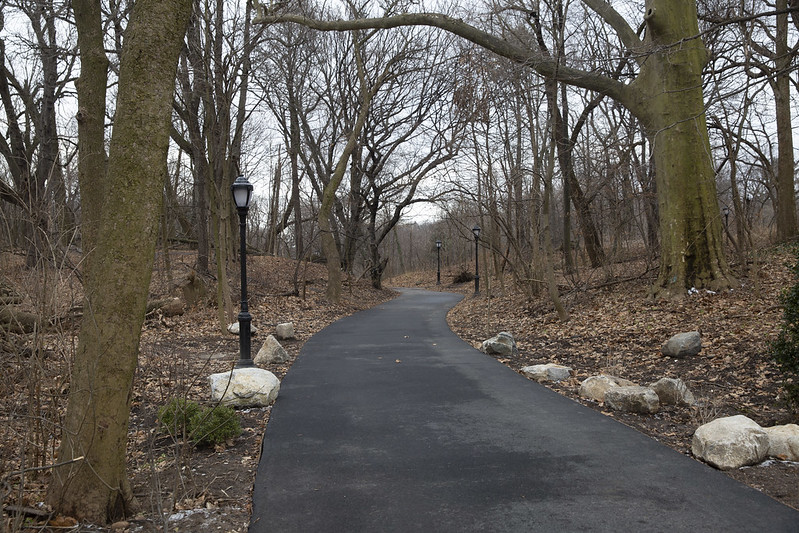
Prospect Park (photo: John McCarten/City Council)
Recently, reading a book to my kids, we reached a point where the protagonist felt overwhelmed by too many challenges. “Cut it into smaller slices,” one of my twin six-year-olds wanted to suggest to the story’s hero, “like you do to my apple.”
From confronting our climate crisis to imagining how to reinvent our streets to be safe for my kids and all New Yorkers, the challenges can feel overwhelming. But what if we slice up this apple?
Greening our city — from livable streets to a sustainable future — can and must begin immediately. Big ideas that I strongly support such as the Green New Deal for New York City, require big, citywide policy changes, including state approvals; and areas of work close to my heart like investing in our parks and playgrounds, require citywide efforts. Yet there are plenty of actions we can start now at the neighborhood level.
The apple has already been sliced for us by dynamic and impactful non-profit groups in communities in Brooklyn, and around the city — and building on ideas from these groups, we’ve compiled a set of actions that, as I run for City Council in Brooklyn’s 39th District, I am ready to act upon to help create change at the neighborhood level: going big on rooftop solar energy; safer streets and pedestrian-first zones; reducing the carbon footprint of our food and waste; and accelerating the cleanup of toxic legacies in our backyard. These are actionable items to help those who call Park Slope, Windsor Terrace, Kensington, Borough Park, Gowanus, Carroll Gardens, Cobble Hill, and the Columbia Waterfront District home or who work, visit, or go to school there.
Solar roofs present a straightforward, win-win opportunity. The cost has been dramatically reduced, the technical issues have been solved, and we now have a number of installers with deep experience with New York buildings (including at least one company based in the 39th Council District).
What is now missing is an effort to put rooftop solar right in front of people’s noses. Big, transformative ideas like public renewable utilities and large-scale offshore wind are worthy, but will take time and require state approvals. All the tools to dramatically increase rooftop solar are available but need to be taken to scale: a door-to-door campaign to sign up for solar, a “public option” for community solar for renters, and financing tools to eliminate upfront costs. I’m especially excited about job training programs for solar installation as a pathway to the middle class.
There are just as many actionable ways to move forward on safer streets. I walk and bike with my kids around Brooklyn. My picture of a cyclist isn’t a super-athlete, it’s a parent ferrying kids, a delivery person, or my 76-year-old father who still criss-crosses the city on two wheels, with his new hip.
We need to transform how we protect our cyclists, strollers, seniors, and pedestrians—and how we reimagine public streets as public spaces. Our term-limited Council Member Brad Lander has shown that a local Council member can make a difference.
I’d build upon that track record by focusing enforcement and design solutions on the most dangerous intersections. I’d be a champion for going further to create and sustain public spaces for play, outdoor schooling, restaurants, culture, retail and community gatherings. In 2022, I’d work to make sure there is an on-going “open street” in each neighborhood and pilot a multi-block “pedestrians-first zone” in one neighborhood.
And let’s make it easier, more accessible and more affordable to get around our city—expanding Citi Bike throughout Kensington, each year rolling out a neighborhood bike network safe for ages 8 to 80, and invest in programs that make it easier for everyone to have and safely secure a bike.
We can immediately do better on waste and our food systems, areas where the last year has seen our city going backwards. It was a real blow to lose curbside collection of composting. I am grateful that community-based composting organizations rallied to preserve drop-off sites. But we can get the municipal program back on its feet in a cost-effective way through block-by-block outreach and complement it by making textile and e-waste recycling available to every block. At the same time, let’s pilot a containerization program on a commercial corridor to eliminate trash bag piles.
The cooperative economy also offers solutions. Food coops, mutual aid networks, and “buy nothing” groups provide a growing constituency to go to scale on reducing our consumer carbon footprint. I’ve spent two decades creating organizations that use social capital and collective effort to create big change and would help support and connect these newer and more established cooperative models to see what we really can accomplish together.
Finally, this isn’t limited to our district but there is a unique opportunity for us to go big on accelerating the cleanup of toxic legacies in our own backyard. The Gowanus Canal has been burdened by a historic legacy of toxic industry, with added pollution from combined sewage overflows (CSOs) into the canal from the city’s sewers everytime it rains. The work led by Rep. Nydia Velazquez and the EPA under the Superfund program deserves to be done as quickly as possible. Together we can move quickly on the city’s commitments to reduce CSOs and ensure sites are cleaned up to appropriate standards safe for residential uses.
And I recommit to the deal-breaker conditions for investment in NYCHA and environmental justice goals set by the Gowanus Neighborhood Coalition for Justice for any forward movement on the Gowanus Rezoning. Regardless of what happens with the rezoning, cleaning the Gowanus and supporting it as a vibrant, sustainable, and mixed-use neighborhood is a generational project that requires ongoing engagement and leadership.
As we’ve seen even in the worst of this pandemic, local partnerships can have impact faster than waiting for broader policies. One example: A group of neighbors and I came together to establish and expand the Camp Friendship Food Pantry last May, and we now serve hundreds of families each week.
As a City Council member, of course I would use local laws, land use review, and oversight as powerful tools — but to be truly effective, Council members also must use the soft powers of the office: convening local groups, providing a base for organizing around solutions, and bringing people together to solve problems. I’d build on my 20 years of experience as an organizer and institution builder to convene, innovate, and empower to make real headway on climate and safe streets in 2022, and contribute to greening our district, our city, and our future.
When the city began the curbside composting pilot, our building didn’t immediately qualify. I had to research the program, bring it to the co-op board and get buy-in. People were hesitant: Would it lead to more rats? A cluttered garbage area? What if we didn’t compost correctly? With the help of the organics program of the Department of Sanitation, we answered all these questions and opted in as a trial run.
Years later, when the city ended the program, several neighbors who had initially been hesitant came to me: “Justin, you know city government. How do we get composting back?”
The only way we do anything worthwhile: Together.
*Ideas in this column have been drawn from the tremendous work of a range of local organizations — culled from the public reports and programs and numerous direct conversations — including the Gowanus Neighborhood Coalition for Justice, Solar1, the Gowanus Canal Conservancy, BIG Reuse, The HOPE Program, Families for Safe Streets, Transportation Alternatives, the Riders Alliance, the Pratt Center for Community Development, Park Slope Neighbors, Sustainable CUNY, Lower East Side Ecology Center, and more that tackle these issues everyday.
***
Justin Krebs is a progressive organizer, leader of National Campaigns at MoveOn, and a Democratic candidate for City Council in Brooklyn’s 39th District. On Twitter @justinmkrebs
The State Assembly Must Step Up for At-Risk Families Like Mine
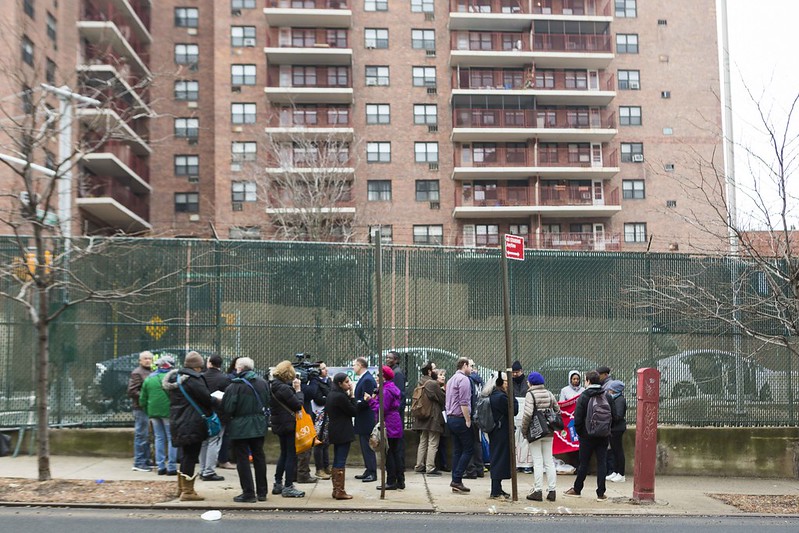
New Yorkers need housing (photo: Emil Cohen/City Council)
[Update: not long after this op-ed published, Assembly Speaker Carl Heastie tweeted the Assembly's support for the HAVP rental subsidy and indicated the Assembly majority he leads would be fighting for its inclusion in the state budget due by April 1]
I am the proud mother of an 18-year-old freshman at John Jay College, who is studying to become a criminal justice lawyer. It breaks my heart that he has to limit his opportunities and turn down potential jobs to prevent us from becoming homeless. That is the twisted logic of our state’s current rental assistance program — but it does not have to be this way.
This week I was heartbroken to see that Assembly Speaker Carl Heastie failed to include critical resources for homeless New Yorkers — namely the Housing Access Voucher Program (HAVP) — in the Assembly one-house budget. With over 92,000 New Yorkers homeless and dying from COVID-19 at astonishing rates, there is really no excuse.
I currently live in a two-family home on Staten Island with my children. We moved to Staten Island from New York City’s shelter system after fleeing a domestic violence situation that put me and my childrens’ lives at risk. I pay rent with what is called a “Family Homelessness and Eviction Prevention” (FHEP) voucher. My daughter and I both receive Supplemental Security Income (SSI) and we are eligible for rental assistance because of my son’s public assistance case. We are dependent on this income to pay our $1,534 monthly rent. My son wants to work and is able to work, but if he works more than 20 hours per week, his public assistance case will close, and we will lose our voucher and become homeless again.
Our landlords live below us, and our relationship has gotten worse over time. I am a constant target of their harassment and they have been trying to push me and my kids out onto the street in the middle of a pandemic. I am under incredible stress every day and it has taken a serious toll on my mental and physical health. I never feel safe – in fact, I feel like I am back in an abusive relationship all over again.
I have been trying desperately to move out of my apartment into a new place for the last 13 months, but the City will only cover $1,580 in rent for a family of three. This is what a studio apartment costs in New York City. I feel trapped: stuck in an unsafe apartment with rent I can’t afford; if my son gets a job I will lose the meager assistance I have but we want him to succeed.
My story is not unique. The alphabet soup I just described -- FHEPs, SSI -- might seem alienating to the average New Yorker. It’s alienating to me, too. But this is the cruelty of being homeless in New York: in order to get and keep public benefits, families like mine are forced to turn down opportunities, struggle in unsafe housing, and face byzantine processes that stop us from living a life with dignity every single day. And the vouchers still don’t cover rent to allow families like mine necessary flexibility.
HAVP is a stable rental subsidy that would help families like mine find permanent homes instead of moving from one bad situation to another. A program like this would change my life and the lives of tens of thousands of other people across New York State. It would pay fair market rent and challenge the status quo of current welfare programs that limit upward mobility by allowing my families’ income to increase until we are able to pay our rent independently. It would also cover undocumented people, as well people on social security and other fixed incomes — communities who currently have no rent support options.
There were 92,000 New Yorkers homeless before COVID-19 and if nothing changes that number is sure to grow. The New York State Senate has acknowledged that crisis, and included HAVP in their one-house budget proposal. But once again, the Assembly is leaving us behind. Without HAVP, the Assembly is leaving thousands and thousands of New Yorkers who have been at increased risk of exposure to COVID-19 and dying since the beginning of the pandemic. It’s shameful.
In order to recover from the pandemic, we need rental assistance for the homelessless. Along with it, we need to tax the wealthy (by passing the Invest in Our New York Act), make eviction protections like ‘good cause’ permanent, and forgive back rent. As homeless New Yorkers know best of all, Governor Cuomo is no friend. But Speaker Heastie must negotiate with Senate Majority Leader Andrea Stewart-Cousins and stand with us during final budget negotiations. Both houses have a supermajority. They should use it to create a budget that will sustainably fund our state out of this crisis and into a better future, making sure to finally take steps needed to address our homelessness crisis and help thousands of families like mine.
***
Gizel Garcia is a mother, and a young, ambitious, and disabled New Yorker. She is a leader in the Community Action Program at Neighbors Together, a community based organization located in central Brooklyn that organizes homeless and formerly homeless New Yorkers. She is an active leader with the Housing Justice for All campaign.
***
Have an op-ed idea or submission for Gotham Gazette? Email This email address is being protected from spambots. You need JavaScript enabled to view it.
Leading Mayoral Candidates Show Yeshiva Ignorance
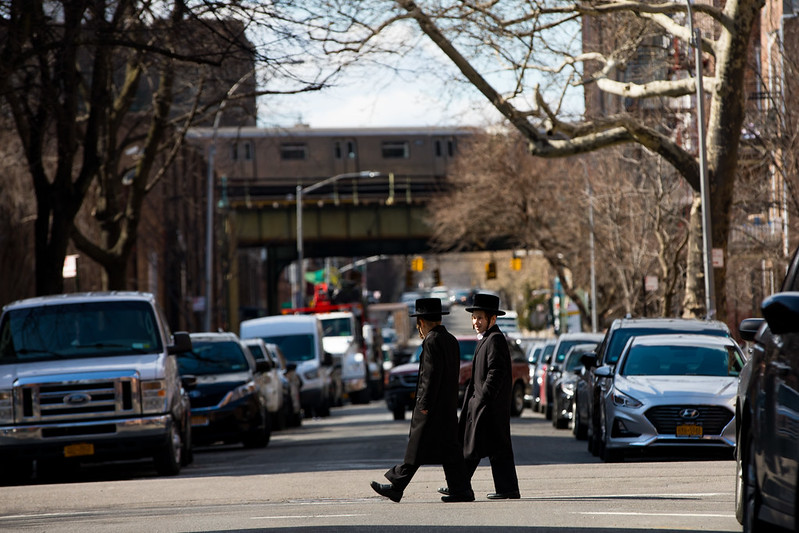
A Brooklyn scene (photo: Benjamin Kanter/Mayoral Photo Office)
In his new book Think Again, psychologist Adam Grant discusses the art of rethinking our ideas and beliefs and how vital this is towards progress. He explains how politicians are particularly prone to falling into a Politician Mode. It’s where one seeks approval and support from an audience with the goal of winning them over.
Grant’s theory was top of mind as I have watched several of the New York City mayoral candidates go into full-blown Politici an Mode in their effort to win over the highly sought-after Hasidic bloc vote. One issue, in particular, stands out: secular education.
As a graduate of Hasidic yeshiva that did not provide me with a proper secular education, it’s astonishing to see how ill-informed two of the mayoral candidates are on the issue of yeshiva education.
This week, Eric Adams posted a video of himself on Twitter filmed during a brief visit to a Hasidic elementary school. Adams makes a series of inaccurate statements. He labels critics of Hasidic yeshiva education as “outsiders” when, in fact, the complaints against yeshivas were made by a group of parents and former yeshiva students, such as myself. While attending a Hasidic high school we never received any secular education (i.e. basic writing and reading of English, science, history, etc.), and in elementary school, we received just under 90 minutes of secular studies per day.
Adams also makes strange comparisons between the effort to improve secular curriculum in Hasidic yeshivas and the problems African-American and Hispanic students face due to a lack of culturally-competent education in their schools. We never devalued or attacked cultural or religious education—we merely proposed having a robust dual curriculum as they have in the majority of non-Hasidic Jewish schools.
At a mayoral forum on February 18, Andrew Yang also stated that he wouldn’t “interfere” with “faith-based learning”—essentially offering assurance to the Hasidic community that their schools will be allowed to continue breaking state law and not properly educating students. In a bizarre anecdote, he mentioned how he valued his one month of bible education back in high school, where he said he studied it as “literature,” proving that he was misinformed on this issue.
In reality, over 50,000 children within the New York Hasidic (a.k.a ultra-Orthodox) school system were found being not educated as required by state law. In December of 2019, the New York City Department of Education released a long-awaited and much-delayed report on some of the problematic Hasidic yeshivas. Of 28 yeshivas reviewed by investigators, only two were found to be providing students with an adequate education in accordance with state law—confirming years of allegations against these problematic yeshivas.
Although this impacts the curriculum at a very specific group of Jewish schools, this issue is of true concern to all New Yorkers. According to the 2020 Census, the towns of Kiryas Joel and New Square in upstate New York are listed as having the highest population growth rates within the state. They are also the poorest towns in the country. Both towns are almost exclusively Hasidic. Growth rates within the Hasidic community of New York City have also been astounding. Data suggests that by 2030, up to one-eighth of New York City’s schoolchildren will be Hasidic, including up to 30% of Brooklyn’s schoolchildren. Unfortunately, the lack of secular education dooms most young Hasidic graduates to lives of poverty and dependence on government aid. It's not hard to imagine the economic stress the State and City may face if this isn’t acted upon soon.
We aren’t expecting a new mayor to come in at the beginning of next year and overhaul the Hasidic yeshiva curriculum overnight. But we do need a mayor who understands and acknowledges an issue of this magnitude and prioritizes the education of these children. We need a mayor who will create change for the betterment of all children, not only try to appeal to adult voters.
Grant discusses another mode of thinking, the Scientific Mode, in which one is aware of the limits of their own understanding, remains curious, and updates their views based on new information.
We need a mayor who will adopt a scientific frame of mind to solve this issue—a mayor who is only focused on being a politician won’t do.
***
Shlomo Noskow attended Hasidic yeshivas in Brooklyn. He is a member of the board at Yaffed, an organization advocating for improved education in Hasidic yeshivas. On Twitter @yaffedorg.
***
Have an op-ed idea or submission for Gotham Gazette? Email This email address is being protected from spambots. You need JavaScript enabled to view it.
Mayoral Candidates are Talking Smart About Housing. That’s Only the First Step

Housing (photo: Michael Appleton/Mayor's Office)
While there have been no shortage of Zoom forums and candidate discussions, it is fitting that the first televised gathering of mayoral hopefuls focused on housing and homelessness. The city is in the throes of a housing emergency that the pandemic has only exacerbated. One million households were rent burdened before the pandemic and now hundreds of thousands of households are at risk of eviction, with tens of thousands more at risk of foreclosure. This is just one way to quantify the scope of the problem facing the next mayor, who will likely be tasked with providing immediate housing relief to pandemic-impacted households while also addressing the crisis’ underlying conditions.
My organization, the New York Housing Conference, organized a broad coalition called United for Housing – comprising 90 policy experts, practitioners, and advocates from a diverse range of backgrounds – to lay out a policy vision to help combat this challenge. And last week, our coalition was proud to partner with the NYU Furman Center and NY1 to host a mayoral candidate forum that fostered a meaningful policy conversation among frontrunners in the Democratic primary. The fact is that New Yorkers should be encouraged by what they heard – but this is only the first step.
The most encouraging sign is that each of the eight candidates have promised to meet United for Housing’s goal of doubling city capital spending on housing to $4 billion annually. This is a significant promise that reflects the seriousness with which every candidate is treating housing – a spirit we have seen as we’ve briefed candidates on the vision laid out in our report, United for Housing: From the Ground Up, throughout the campaign.
This carried over into the forum, where candidates were pressed on issues ranging from COVID-19’s impact on the housing emergency to the affordable housing and homelessness crisis to home ownership to NYCHA to racial equity. And while there is some disagreement on the best path forward, there is broad consensus on the scope of the problem and even some of the most important solutions.
For example, every candidate agreed to make rental assistance vouchers available to youth aging out of the foster care system – a smart, targeted way to prevent young New Yorkers from experiencing homelessness at a key moment in their lives. Candidates also agreed on the big questions, highlighting that we need to build more deeply affordable housing, that housing, eviction prevention, and rental assistance are essential tools in the homelessness crisis, that NYCHA residents need to be better involved in the future of their homes, and that we need to take an active approach to end systemic discrimination and segregation in housing.
The broad agreement coupled with the fact that so many candidates have boldly committed to such a robust ramp-up of city expenditure on housing is the most significant development of the campaign thus far from a housing perspective. But it alone will not be enough: key differences on the details remain among the candidates, including how they will use that money, where it will be targeted, and even what each means by the term “affordable housing.”
Over the next several months, it will be incumbent on every New Yorker to continue pushing candidates on the details. New York City cannot afford anything less than a real plan that will meaningfully address the problems we are all facing. And it will be incumbent on the next mayor to take the lead: while there are promising signs of new support from Washington, it is essential for every level of government to make a historic commitment on housing to actually move the dial.
This is only the first step. When the next mayor takes office, we will need to ensure that the proper resources are made available and fight for a more affordable New York. After all, the next mayor’s choices will shape not just our COVID-19 recovery, but also the next decade of housing policy – and it is crucial that they get it right.
***
Brendan Cheney is the Director of Policy and Communications at the New York Housing Conference, which convened the United for Housing coalition and authored the From the Ground Up report. On Twitter @brendancheney of @thenyhc.
***
Have an op-ed idea or submission for Gotham Gazette? Email This email address is being protected from spambots. You need JavaScript enabled to view it.
New York Must Give Criminalized Trafficking Survivors Like Me a Fresh Start
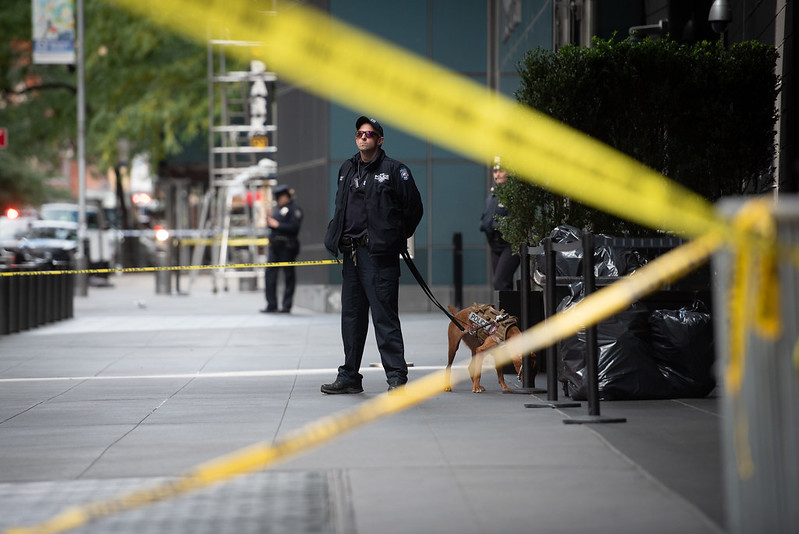
Police lines (photo: Michael Appleton/Mayoral Photography Office)
In the back of a police car after my arrest, I remember thinking: at least I am going somewhere my trafficker can’t hurt me.
It was 2010, and I had met a man who trafficked me into prostitution. At 23, I was a vulnerable target. I had fled an abusive home in Mexico for Brooklyn. I was undocumented and live d in fear of deportation. My family in New York had kicked me out because they did not accept my identity as a transgender woman. I stayed with friends who introduced me to a man who, at first, offered me the attention and affection I craved -- then turned on me.
Once I had come to trust him, he beat me, raped me, and forced me into sex work, setting up "dates" for me on Craigslist and taking the money. He threatened me with a knife and said he would call immigration on me. He gave me drugs and alcohol and then threatened to withhold them if I didn’t work for him. I had no idea how to get out.
Perhaps worst of all, my trafficker used me as bait so he could commit knife-point robberies of the men he forced me to have sex with. I was arrested by an undercover cop and charged with one of those robberies.
Nobody in the system asked what happened to put me into that situation. Even though I was being abused, I was afraid to tell the police what was going on. If they had known my trafficker made me do the robberies, would things have been different? I feared his continued abuse; I feared the police; I feared I would be sent back to Mexico. Because of my fear, I just stayed quiet, and it was the worst feeling in the world. I was already traumatized by the abuse I was suffering. When the police went through my personal belongings, swabbed my mouth, fingerprinted me, and laughed at me, I felt worthless.
Victims are supposed to be protected by the law, but I wasn’t. It felt so easy for everyone in the system to treat me like garbage they could toss out. I am a good person but being in the courtroom made me feel like the worst person in the world. I ended up pleading guilty because I felt powerless, saddling myself with a criminal record. The conviction posed a new obstacle to my immigration process and served as a constant reminder of my trafficking experience – another way my trafficker had marked me.
In 2009, New York became the first state in the country to allow human trafficking survivors to clear prostitution convictions from their criminal records. This law has provided some measure of justice to people forced into prostitution and arrested for it. However, it does not address all of the other offenses that traffickers compel victims to commit by using force, fraud, or coercion. As a result, it still leaves trafficking survivors like me with criminal records.
Now the New York State Legislature is considering a bill to expand a trafficking survivor’s right to relief. The START Act, sponsored by Assembly Member Richard Gottfried and Senator Jessica Ramos, has been introduced in both houses this session, but hasn’t yet come to a vote in either house. It would empower courts to clear any criminal convictions resulting from human trafficking, and it could provide justice to the many people who found themselves in circumstances like mine. The Legislature should vote on it as soon as possible.
Today, I have been granted asylum in the U.S., and I am working to restart my life as an activist. Fortunately, I was able to clear the robbery conviction from my record, with the efforts of my legal team and an agreement worked out with an understanding prosecutor. But under current law, most trafficking survivors are not able to do this, even though their offenses were entirely the result of being trafficked. Justice shouldn’t depend on where you live or where you were arrested. All trafficking victims in New York State deserve access to a clean slate.
I am sorry for what happened; every night I still pray for forgiveness. But I was under the control of my trafficker, and the law didn't understand that.
Passing the START Act would mean that trafficking survivors can fully move on with our lives, get a fresh start and feel less alone. We need to be able to clear the criminal records that hold us back. New York must protect victims like me and pass the START Act now.
***
N.R. is an activist for immigrant rights and a member of the New York Anti-Trafficking Network’s START Coalition, a group advocating for passage of the START Act. Kate Mogulescu is the director of Brooklyn Law School’s Criminal Defense & Advocacy Clinic, which worked with N.R. to clear her record and on this column, and represents other criminalized trafficking survivors.
***
Have an op-ed idea or submission for Gotham Gazette? Email This email address is being protected from spambots. You need JavaScript enabled to view it.
It’s Time to Bring Joy Back to New York
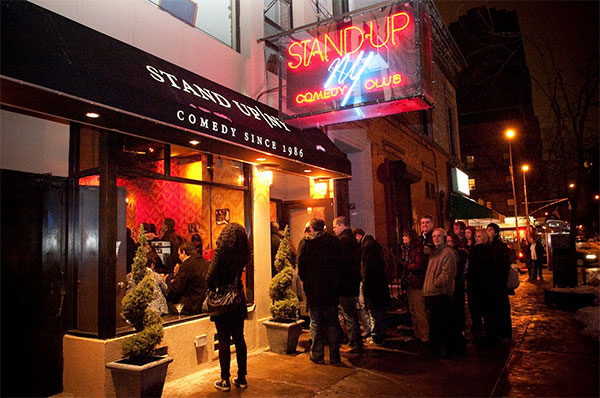
Stand Up NY
Laughter brings people joy, something that we’ve been missing for so long in New York thanks to the shutdowns by Governor Andrew Cuomo. We need New York to heal. That’s why I convinced my friend Dani Zoldan, the owner of Stand Up NY, to sue the governor.
Prior to this lawsuit, Dani was putting on shows in parks and subway cars. He was working around the mandates imposed on small businesses by the governor and other elected representatives. Dani skirted the law and put on comedy shows without a license, because the law was unjust. It was this injustice that left no choice but to take legal action. Dani said, “The comedy scene in New York City is the best in the world. The overall consensus is that comics want to perform again, New Yorkers want to laugh and venues want to receive guidelines so they can safely reopen.”
He’s right.
Getting this right required conversations with numerous lawyers, including Democrats, Republicans, and Libertarians, among others, and they had different approaches to this case. Some were too expensive. Others didn’t have the right experience. Some had positive results in bringing suit, but didn’t come across as compelling litigators. After numerous consultations, we felt good about hiring James Mermigis, the “Anti-Shutdown Lawyer.” But, there was a problem.
Imagine being a comedy club owner on the Upper West Side like Dani—who considers himself an independent with progressive values, teaming up with Mermigis, who voted for Trump. Dani depends on the local community to put food on the table, and this might feel like doom for a small business. But that’s not the case.
Part of the healing process is bringing people together. After four years of heated debates and a year of social isolation forced upon us by the governor, it’s time to bridge the divide. Dani and James were a great match because they think differently, yet want the same outcomes.
Dani and James may not agree on everything, but they agree on enough. This team championed the arts, culture, and small businesses that are dear to our hearts. We announced the lawsuit on The Sharpe Way, and raised awareness with LegalizeComedy.NYC. The lawsuit was filed on March 1, and Dani went on a media blitz the next day. By March 3, Governor Cuomo announced that he would permit entertainment venues to open on April 2. Pushing him into a corner to make the right decision was a huge win for our wonderful city. With comedy and other entertainment come laughter and joy.
Dani was not just representing his club. He was representing the community of local comics and other artists in New York who could not work, because of these suffocating mandates. We went to battle with the governor, head on. We won. We’re bringing back comedy clubs, laughter, and joy. We have a chance to heal.
***
Larry Sharpe is host of The Sharpe Way and was the Libertarian Party nominee for governor of New York in 2018. On Twitter @LarrySharpe.
***
Have an op-ed idea or submission for Gotham Gazette? Email This email address is being protected from spambots. You need JavaScript enabled to view it.
Missing Pieces of the Pot Discourse
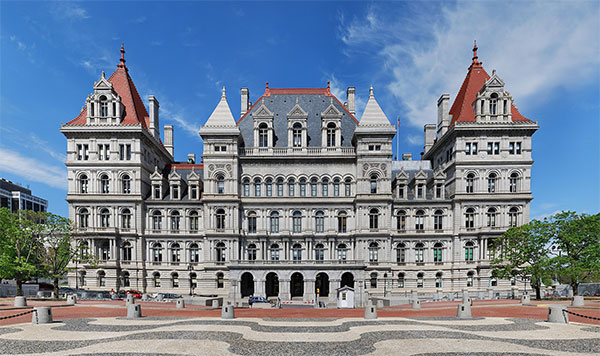
The State Capitol in Albany (photo: CC-BY-SA-3.0/Matt H. Wade at Wikimedia Commons)
In a recent column published by Gotham Gazette, Manhattan District Attorney candidate Diana Florence extolled the push to commercialize marijuana in New York as a means to shore up our budget issues and solve social justice inequities. In short, the former Assistant District Attorney’s piece, like many other arguments about moving full-steam ahead with legalization, is quite far off the mark — here’s why:
Our state took an enormous blow from COVID-19. As a result, Governor Cuomo and others in Albany are scrambling to find ways to fix our shortfall, but we must not fall for the canard that allowing Big Pot in is the fix.
Governor Cuomo and others who are pushing for commercialization have claimed that legalizing marijuana would bring in $350 million a year in revenue. What’s missing from this is the fact that New York wouldn’t see pot revenues for quite some time. Ironically, both the main sponsor of the Senate’s legalization bill, Senator Liz Krueger, and State Budget Director Robert Mujica have been urging caution on claims that pot taxes will cure our budget woes.
As it stands, even if marijuana revenues appeared overnight, $350 million is akin to a speck of sand on the $15 billion beach that is our budget shortfall. In all, it’s just 0.2% of the overall $170 billion state budget.
And we haven’t even begun to discuss the costs associated with legalization: a study out of Colorado found that for every dollar in pot tax revenue, $4.50 must be spent to mitigate the increases in mental health and substance abuse issues, marijuana-related hospitalizations, drugged driving deaths and car crashes, and losses to workplace positivity.
Today’s marijuana is nothing like the weed of days gone by. Marijuana use has shown some significant links to serious mental health conditions — including schizophrenia, anxiety, depression, and suicide. Prolonged use has also been shown to lower IQ and motor function and can cause particular damage to the developing brains of young people. And we know this from low-potency pot; the science is still out when it comes to the super-potent marijuana readily available in “legal” states, but new evidence is beginning to paint a concerning picture.
A 2019 study found that users of higher-potency marijuana were more than five times as likely to develop a severe mental illness such as schizophrenia or psychosis. And other evidence tells us that the higher the THC potency, the higher the risk for dependence and problematic use.
Florence is right that more must be done to address racial inequities faced by communities of color, but marijuana commercialization if far from the right answer. All told, only 4% of the industry nationwide features Black ownership while pot shops are disproportionately located in communities of color, which historically lack the resources to combat predatory marketing and would be deeply harmed by increased substance abuse issues. Illinois serves as a perfect example of this.
Lawmakers there promised to “set the standard” when it came to social equity in the marijuana industry. In reality, now a year later, there is not a single minority-owned marijuana retailer in the state. Instead, licenses have gone to existing multi-state operators and connected political insiders. Social justice? Not so much.
If we truly want to help fix the damages of prohibition, we must double down on the current policy of decriminalization, expunge prior convictions, end the stigma that follows those with a drug conviction, and work to expand efforts on substance abuse prevention and treatment. Allowing a for-profit industry to come in and further harm vulnerable communities is not the answer, and it most certainly won’t fix our budget woes.
***
Dr. Kevin Sabet, PhD, is a former senior drug policy advisor to the Obama Administration. He currently serves as president of Smart Approaches to Marijuana (SAM). His new book, “Smokescreen, What The Marijuana Industry Doesn’t Want You To Know,” will be released April 20.
***
Have an op-ed idea or submission for Gotham Gazette? Email This email address is being protected from spambots. You need JavaScript enabled to view it.
Voting Rights Restoration A Good Step But New York Must End Blanket Disenfranchisement
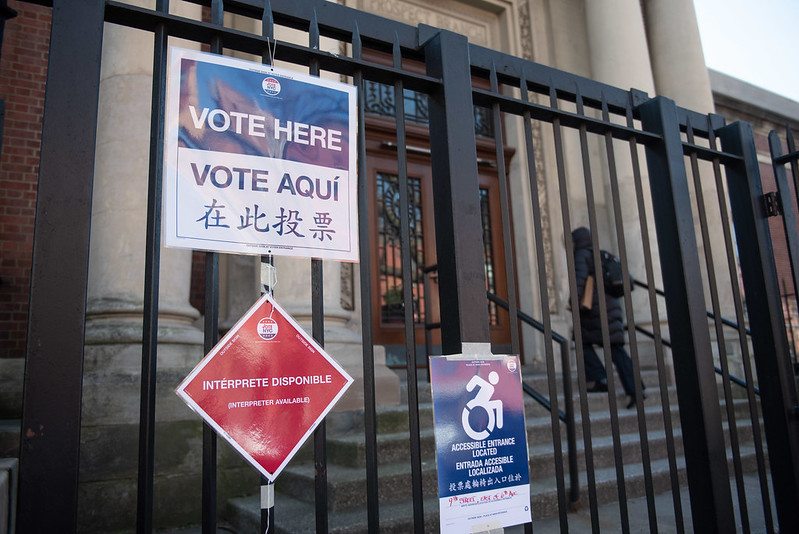
Voting rights (photo: Michael Appleton/Mayoral Photography Office)
Voting rights and social justice advocates are counting on legislative supermajorities in Albany to begin tackling a long ignored civil rights imperative, reform of New York’s racist Civil War-era blanket voter disenfranchisement law, which strips citizens of their right to vote while in prison or on parole for a felony conviction, regardless of the nature or circumstances of the offense.
For the first time since the early 1970s, the New York State Legislature has begun to grapple with that legacy. The State Senate recently passed incremental legislation to restore voting rights to citizens on parole, and the state Assembly is poised to do the same soon.
The policy shift is a decades-long priority of voting rights groups who penned a letter to state leaders about rights restoration ahead of the 2021 legislative session. At the federal level, New York Rep. Jerry Nadler’s Democracy Restoration Act would set this standard nationally for federal elections.
Around 36,000 people are on parole in New York, nearly three-quarters of whom are non-white. A 2020 Columbia University Justice Labs Report concluded that “the impact of current parole practices in New York falls disproportionately on Black and brown communities.”
Governor Cuomo mitigated this in 2018 by signing an Executive Order, a mechanical but meandering stopgap of rolling voting-rights-only pardons. With notable exceptions, rights are restored. However, the process takes several weeks and is disconnected from voter registration (New York’s deadline is still 25 days before an election). It is no substitute for updating the law.
The legislative fix creates a bright-line policy that is easier for election officials to administer, cuts government red tape, and harmonizes the rules so citizens serving out parole in their communities can register to vote, just as New Yorkers on probation presently can.
Voting rights restoration is an impactful step in the right direction. But in light of the historical record and contemporary racial and political impact, New York must be the place where lawmakers feel compelled to drag the United States into modernity.
While a national reckoning with the ongoing legitimacy and wisdom of disenfranchisement policy has been slowly brewing, the racially-motivated proliferation of these laws—intertwined as they are with the systemic marginalization of minorities—has yet to generate the cultural outrage needed to render their perpetuation intolerable and spur real action.
New York is one of 48 states that impose a disenfranchisement policy as a collateral consequence of all or almost all felony convictions, regardless of the nature of the offense and without consideration or review by a judge. Meanwhile, Americans convicted of felonies in Maine, Vermont, or Washington DC retain the right to vote during incarceration.
From a national perspective, this makes the right to vote in the United States startlingly elastic. Internationally, U.S. policies violate norms of proportionality set decades ago by the European Court of Human Rights and are a clear outlier in scale and scope compared to the practice in other modern democracies like Canada, Israel, South Africa, Australia, and New Zealand.
In 2020, the combination of mass incarceration and disenfranchisement policy excluded an estimated 5.2 million Americans from voting, three-quarters of whom have already completed their prison term and are living in our communities. The blunt application to all felonies makes the penalty indiscriminate and yet the impact is unjustly disproportionate—nationally, one in 16 voting age African-Americans were reportedly disenfranchised, a rate 3.7 times greater than that of other Americans. In Florida and six other states, more than one-in-seven African-Americans remain disenfranchised. Over 20% of Americans disenfranchised are women. When combined with other barriers to voter access (and gerrymandering), how dramaticall y does this contort political power?
Disenfranchisement isn’t merely a vestige of Jim Crow in New York, but actually more of an enduring centerpiece of the backlash that also occurred in northern states with larger Black populations after the Fifteenth Amendment prohibited racial discrimination in voting. Sadly, much as delegates intended when they entrenched mandatory disenfranchisement for infamous crimes in the New York Constitution 150 years ago, its legacy operates with disparate racial impact to this day, stigmatizing individuals and perpetuating a ripple effect that marginalizes communities.
The policy is part of a national stain. Course-correcting it requires more than incremental fixes. A rising generation of New York lawmakers are increasingly likely to agree but that’s yet to meaningfully shift the debate. Politicians called to public service to right historical wrongs and pursue social justice must reevaluate this serious punishment through a modern lens focused on fundamental rights and familiar rule-of-law principles like proportionality and judicial oversight.
One option is not to disenfranchise Americans at all, as State Senator Kevin Parker has proposed. But if our criminal justice system will continue disenfranchising citizens convicted of crimes, today’s blanket penalty should be reformed to bear some relationship with the nature of the offense, rather than the length of sentence (it often lasts longer in many states).
Lawmakers can draw inspiration from the civil rights norms arising out of Article 25 of the International Covenant on Civil and Political Rights (ICCPR), which the U.S. ratified decades ago. A pro-voter framework in a modern democracy ensures voting rights remains the rule rather than the exception. That needs rebalancing. Yet disenfranchisement can be reasonable where it is imposed by law or at the discretion of a judge for a limited time, to redress serious offenses against our democracy, like crimes with a nexus to elections, public corruption, abuses of power, treason or terrorism.
The blanket policies in place now are both overinclusive and underinclusive, sweeping in almost all citizens convicted of felonies unrelated to these interests while sparing those convicted of lesser crimes that may directly implicate them, or better-resourced persons who do less time.
The modern disproportionate racial impact requires us to address these policies’ racist origins. To better serve the interests of justice and protect civil rights, Americans should demand uniform rules of specific and proportional application and automatic rights restoration upon release. New York can and must take a significant step forward this month.
***
Jarret Berg is a New York attorney and the Co-Founder of VoteEarlyNY. On Twitter @JarretBerg.
***
Have an op-ed idea or submission for Gotham Gazette? Email This email address is being protected from spambots. You need JavaScript enabled to view it.
‘Cuomo’s Coronavirus Coup’ Revisited – One Year Later
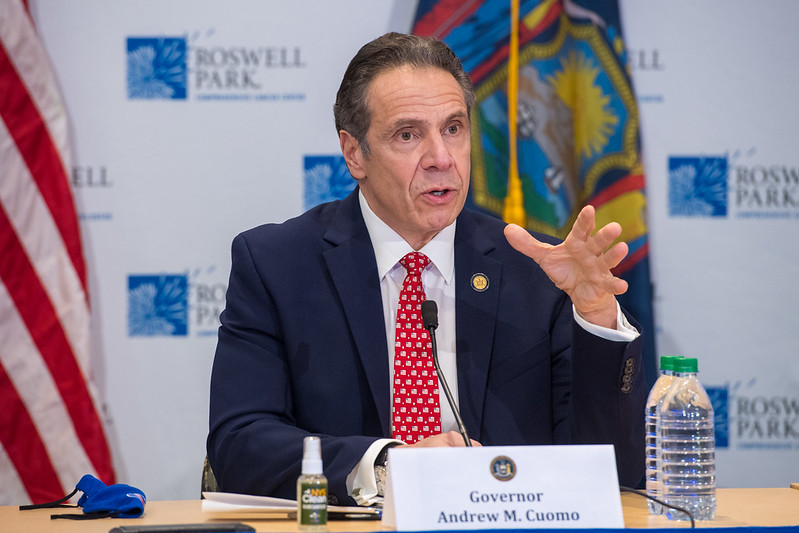
Gov. Cuomo (photo: Darren McGee/Office of Governor Andrew M. Cuomo)
It can be painful to look back, but perhaps never more than as we approach the one-year anniversary of the pandemic. COVID-19 started long before March 13 2020, but that was the day everything changed in New York City. That was the day leaders declared a state of emergency and began the most dramatic shutdown in the city’s history. And that was also the same day I decried what I called “Cuomo’s Coronavirus Coup.”
I’m hesitant to revisit last year’s column, but I think it’s important to look back at these moments, both at the things we got right and the ways we were horribly wrong. Rereading my own words, it’s jarring how wrong I was at times. I truly could not imagine the scale of what we were about to endure, or just how incompetently we would respond.
I wrote about emergency funding requests in the “millions,” when our state would soon spend many billions. I talked about the need to hold legislative hearings without realizing that in-person gatherings would soon be impossible. And I also naively assumed that our nation would come together in this crisis. It’s excruciating to read myself say that there “should be few things less divisive than how we respond to a public health crisis.”
And there’s the title itself, flippantly using the word “coup.” Back then it seemed like harmless hyperbole, but that was before armed right-wing extremists stormed our Capitol and made “coup” a lethally serious word in the present.
But there were parts that stood the test of time, most presciently the warnings that Cuomo’s powers pose a threat to democracy itself.
The change that originally prompted my column was a (at the time) little noted amendment to state law that fundamentally rewrote our constitution. A last-minute item, passed without debate or hearing, let the Governor “issue any directive during a state disaster emergency…necessary to cope with the disaster...”
In other words, for over a year, we haven’t had three branches of government in New York State, we’ve just had Andrew Cuomo. Certainly, the Legislature could have tried to reassert power, especially after those first frenzied months, but its majorities largely gave deference and control to Cuomo. And power predictably did what it does so often, it corrupts…it corrupted absolutely.
Prior to the pandemic, the New York governor already had the power to suspend any law he wanted. If there was red tape that was getting in the way, he could have cut it. But this emergency bill was something new, something unlike what exists in any other state. Here, Cuomo was given the power to make new laws, any law, so long as he said it was necessary for the pandemic.
Some of those emergency measures were helpful, but some were misguided, or even deadly. When the governor ordered hospitals to discharge patients more quickly. It became the law. When he told nursing homes that they couldn’t turn away COVID-19 positive residents, they had no choice but to comply. And when a once-co-equal branch of government started asking questions, he lied, he stalled, and he threatened.
Bullying tactics were nothing new to Cuomo, but the power of being a COVID Caesar left him untouchable as long as lawmakers refused to act, especially when bathed in the light of the national media. But as I write this column, it’s unclear if Cuomo’s governorship will outlast the Ides of March, or if his rule will come to a swift end.
Whether or not Cuomo resigns, whether or not he is impeached, the Governor’s powers will remain. In recent weeks, Cuomo signed a “repeal” of the emergency rules, but that measure is a repeal in name only. Under the new standard, the Governor can extend his prior decrees indefinitely so long as he gives advance notice to the Legislature. The 96 executive orders already on the books remain the law of the land. And the Governor also retains pre-pandemic powers to suspend any law at any time.
This is simply too much power for any one person, but especially for Andrew Cuomo. What I knew a year ago was that Governor Cuomo was a bully, eager to strike out against anyone who spoke against him. In the days following my first column, more than one person told me that my “career was cooked.” But what I didn’t know then, and nearly every New Yorker knows now, is that he’s also a serial harasser, accused by a growing list of former staff members.
Any one of these abuses: the sexual harassment, the nursing home deaths, the cover-ups, and the subjugation of democracy, would be enough to call for an end to this troubled term. But taken together, they are far more, not just an indictment of one man, but of all those who let him amass and abuse so much power. Removing Cuomo from office is important, but that is just the beginning of restoring democracy to New York.
***
Albert Fox Cahn (@FoxCahn) is the founder and executive director of the Surveillance Technology Oversight Project (S.T.O.P.) at the Urban Justice Center and a fellow at the Engelberg Center for Innovation Law & Policy at N.Y.U. School of Law.
***
Have an op-ed idea or submission for Gotham Gazette? Email This email address is being protected from spambots. You need JavaScript enabled to view it.
Envisioning a Community Farm for Our Neighborhood, and Yours
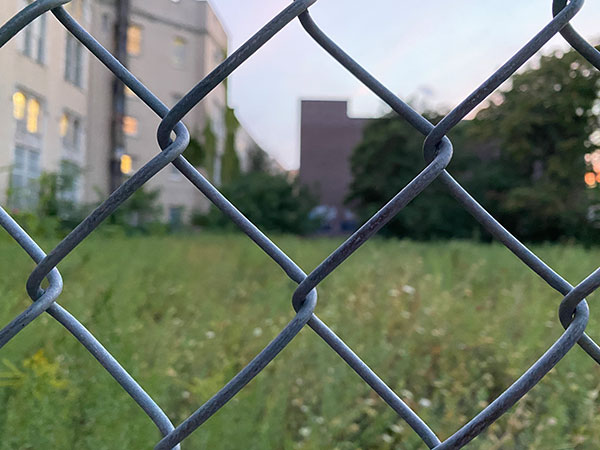
The Brooklyn lot in question
Our needs for housing, food security, health, and green open spaces are all critical. Therefore, city policies and planning must not pit these needs against each other.
Seldom considered are the health benefits provided by greenery. Connection with nature has been shown to reduce heart rate, blood pressure, and stress hormone levels, and positively impact the nervous system. Green vegetation in open social space is key for fortifying mental and physical health as we recover from the coronavirus pandemic.
One particular example where we live is emblematic of how city government must think differently about community space. This story has lessons for New York City. This site may not be in your community, but it is important for the city we all call home and other neighborhoods that may face similar choices.
Brooklyn’s “Block 5103, Lot 58” is a vacant lot at the heart of the historic Village of Flatbush. We believe that a community farm is the highest and best use of this 29,000-square-foot city-owned property at Church and Bedford Avenues. Such use would provide a more livable environment for current residents and would honor those who came before us: the Munsee Lenape and Canarsie peoples who walked this land, and the enslaved of African descent who are thought to have been buried on this lot.
Since 2015, when the dilapidated school building was demolished on the lot, nature has reclaimed this land. Previously, it was the site of the Flatbush District No. 1 School (1878), P.S. 90, and the Beth Rivkah Institute. Around 2006, it was discussed as the site for a Caribbean trade center and business incubator. In 2017, a Community Board 14 study identified this lot as potential green space in a district “ranked 58 out of 59 community districts in the rate of residential units that are within ¼ mile of a park.”
Now is the time to partner with nature to return this lot to the ecological richness of Lenapehoking in support of modern life. Here, neighbors would congregate to chill out and converse among green plants or recall the love of farming in distant ancestral lands. Children would grow, directly connected with nature; both young and old would learn local solutions to food insecurity. Everyone would compost food scraps to nurture the soil and recycle to protect the earth.
A community farm at this location would be the critical center in a community-based plan for a truly livable and affordable neighborhood. We join with local grassroots voices and progressive planners calling for prioritizing renovation and the upgrading of existing housing stock as well as the development of additional deeply affordable housing, based on the area median income, within a two- or three-mile radius.
In line with the real estate appraisal concept of highest and best use, this lot should be removed from the speculative real estate market and held by the Brooklyn-Queens Land Trust. A community farm would serve as a social hub and educational center for earth-serving careers of urban farming, composting, recycling and soil-rehabilitation. Regenerative farming practices that acknowledge the natural circularity of air, water, and soil would develop it at much lower financial and environmental costs. Organizationally, the community farm center could draw on the experience of such community-based organizations as CAMBA, Earth Matter, and East New York Farms, and would receive support from the city.
Currently, there is a consultation process with the expressed goal of developing 130 housing units on this lot. Conducted by the New York City Economic Development Corporation and Department of Housing Preservation and Development, and co-chaired by Borough President Eric Adams and City Council Member Mathieu Eugene, this consultation is politically timed to conclude around the time of the June primary elections.
A more people-centered and planet-friendly, more resilient and more equitable future is possible for this lot in this Brooklyn neighborhood—once multi-generational, multicultural, multi-ethnic, and multi-talented voices are truly heard and their desires acted on. Recognizing our neighbors’ rich diverse voices, we raise our own to demand open democratic deliberation without predetermined political commitment.
We believe that when we give back to the earth, the land supports us. A community farm on this lot is a gift that will keep on giving to us all.
***
Marion Yuen, Natalia Sucre, Don Loggins, Tom Angotti, Iola Sims, Anne Schoeneborn, and Carmen Castillo-Barrett are activists, community gardeners, and composters.
***
Have an op-ed idea or submission for Gotham Gazette? Email This email address is being protected from spambots. You need JavaScript enabled to view it.